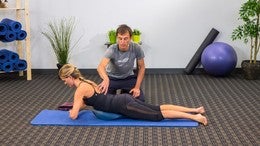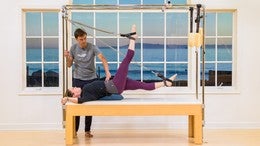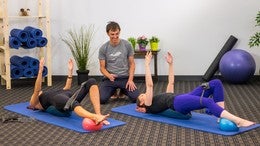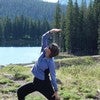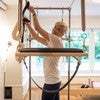Description
Before taking this class, Daniel recommends taking his previous classes and tutorials on the Oov to make sure you are familiar with it.
About This Video
Transcript
Read Full Transcript
We're gonna do a high level intermediate class with the Oov today. If you haven't done a class or anything with the Oov, I recommend you look at our tutorials and our case studies and the earlier classes to build up into this, because there's going to be some pretty advanced exercises in this one. So we're first of all gonna set everybody up on the Oov. They're lying back down into supine or on their back, on the Oov, I want hands on lower ribs, elbows on the ground, we're going to take one leg into tabletop with the bent knee and the other leg into tabletop. Now if you're head lifted up like John, we're gonna take your legs back down, or if you feel any strain in your neck and you're going to move up the Oov.
So you move up towards the small end of the Oov or away from your feet, okay? And you shift up until you find a point that you can balance where when you're taking the legs up in the air, there's no lifting of the head and you're not straining your neck when you're in balance point. So just come up a little bit higher for me. There, awesome, great, that's perfect. There it is, okay.
So one leg back down to the ground and another leg down to the ground. So we're gonna start with some motor control work first, just ease you in. So taking one arm over your head and back and the opposite leg straight into a single leg stretch as that one arm goes over the top of your head. Great, and back. Now as you take that arm over the top of your head and legs straight out for me please, yup, holding that there.
Now can you take that one arm out to the side and the leg out to the side for me? And hold, coming back. And again, hold, coming back. And one more, hold, coming back. Great, and taking that leg and arm back down.
Change sides. So lifting one arm first of all, taking it over your head, bringing it back, don't let it rest on the ground. So keeping it in front of you. Now you're going to take the opposite leg into a single leg stretch and arm above your head. Hold it there.
Now hold and balance, bringing it back up again. Bend the knee back up, arm back up in front of you. And one more time. Hold. Now from here, can you take one arm out to the side and the leg out to the side, holding that there?
Great, coming back. And again. Hold that there. Coming back, one more time. Hold that there.
And coming back, good. Taking the arm down to the ground, elbow, foot down to the ground, have a rest. Now you're going to take your ball and you're going to position it under one elbow. I've got it for you. You're going to position it under one elbow.
So we're going to take that stable base away from you. So you're still going to have that hand on your lower rib but you're going to be able to push into that ball a little bit. Great, okay? Good, so now lift the opposite arm, opposite arm, above you and then taking it over your head to the floor, holding it just off the floor. Coming back.
And again, one more time. Good, and back. Now can you lift the opposite leg into tabletop? Hold that. Now from there, straighten the leg out, straight out while you take your arm above your head, holding that there, great.
Coming back, we're gonna do a couple of these. And again. (mumbles) The ball adds an extra dimension of instability, okay? One more time. Now from there, holding there, can you take one arm, the arm out to the side and the leg out to the other side?
Hold that there, good and back. And again. Hold that there. And back. One more, hold that there.
Excellent. Coming back, bringing the arm back up over your head, bending the knee, foot back down to the ground, elbow down the ground, change the sides of the ball. So we're gonna start with our arm above us, in front of us and taking it above our head, holding it just off the ground. Good, coming back. And again, one more time.
Hold that there, great. And back. Now we're going to take the opposite leg and lift it into 1990 or in tabletop, the opposite leg. That's it. And from there, we're going to straighten the leg as we take the arm over our head.
Fantastic, coming back. And again. Good. And back. One more time.
Now we're going to hold it there. So taking the arm out to the side and the leg out to the side the same time, hold that, feel how you have to work through that anterior sling more coming back. Another one. And hold that there, fantastic. Coming back, and one more.
Out to the side, holding that there, holding that there, coming back, bending the knee, taking the foot to the ground and elbow back down to the ground, have a rest, well done. Well done. I'll take the balls away, awesome. So what we're going to do now, elbows on the ground, we're going to take one leg into tabletop and the other leg into tabletop, remembering that if you feel any straining in your neck or if you feel your head lifting up, you need to move up the Oov, okay? So the first thing we're going to do is a leg lift.
So we're gonna straighten one leg out and slowly coming down to the ground and brushing that wall coming up, pointing your toes. So heel coming down and pulling those toes back up again. And again. Good. Keeping those elbows nice and strong on the ground.
And back. And one more, great. And back. Now change legs. Shooting it out to the long line and slowly coming down and pulling those toes back up again.
So letting the heel lead the way on the way down and then dragging those toes back up again like you're painting a fence paling with your toes. Slowly controlling it, coming back. A couple more. Good, and one more. Excellent.
Take one leg down to the ground and then the other leg down to the ground. Have a little rest. So you did that well so we're gonna add a little bit of color. So what we're going to do is one leg up into tabletop, the other leg up into tabletop. Now we're gonna keep our elbows nice and strong and this is a bent knee fall out but taking the foot all the way down to the ground and touching the ground just underneath your opposite leg.
So bent knee fall out. So start with a bent knee fall out and then take the foot down and coming back. So bent knee fall out and then taking the foot underneath the opposite leg. So it's a bit like a curtsy, that's it. And back.
So this adds transverse plane and then extension of the hip. Good, and back. And just bent knee fall out and then taking it into extinction, great. And again, bent knee fall out first and then taking it in. Good, so you start with a bent knee fall out, good, and then you take the foot to the ground underneath the opposite leg.
A couple more, good. And really taking that bent knee fall out first and then coming down underneath. One more. Good. And now one leg down to the ground and the other leg down on the ground, well done.
So what we're gonna do is do one more and this time we're going to come up, elbows nice and strong, one leg up into tabletop and the other leg up into tabletop, and this time you're going to take that leg straight out on the long line. So straight out and leg circles. So very small first of all. Which way did you go? External rotation or internal rotation?
And as we're moving, we're gonna increase those circles, make them a little bit larger each time you move. You have to control your trunk a lot in this movement. The Oov is really forcing you to control your trunk. You can't rotate your pelvis in this move. Now go the other way.
Good. Keep going. Excellent, so bringing that knee back, pinning the knee back into tabletop. Change legs. Leg out, the other leg out and then circles.
Which way did you go, the same way or the opposite way? What did you find guys? Did you go the opposite way to what you did in the other leg or the same? You did the same? John, you did the opposite didn't you?
I'm pretty sure. Okay, keep going. It's interesting to see which way, when you do this with water polo players, they definitely go external rotation on one side and internal rotation on the other with their egg beater kick. So you train them the other way, and then change legs. And there's always a quality of movement that's not as good to your preferred side.
Okay. A couple more and slowly making the circles bigger as you're going. And back into tabletop, one leg down to the ground, the other leg down to the ground. Now sliding down to the large end of the Oov so your tailbone's lower on the Oov, we're going to take some Thera-Band, tie it around our knees nice and tight. So bring your knees together, tie the bands around your knees.
Excellent. So we're gonna do a little bit of thoracic rotation, like what we did, similar to what we did in the case study, but we're going to add a few variations. Okay, has everyone got it? Yup, awesome. So what we're going to do here is we're going to start with our hands behind our head, elbows just off the ground, just off, okay?
So now see if you can just hold those elbows off the ground and slowly bring one elbow down to the same side hip. Good. And back, great. And the other side. So we're gonna start with lateral flexion first.
We talked about why in the case study, so just dropping the head down a little bit. So keep a little bit more neutral. That's it. And really explore the movement, feel which way is easier, which way is harder. And really, the goal of all these movements is to feel what you need to do to make it easy.
What do you need to do to make this movement easy? And you'll find that as you go along, you'll start to get a little bit more movement. Couple more. Excellent. Now taking the head back to the center and just having a little rest.
Resting back down. Elbows down, relaxed, okay. So what we're going to do now is you're going to look over to one of your elders, turn your head to look at your elbow and now bringing that other elbow over and try to meet it to that elbow. So going only as far as you can, great, and coming back, excellent. And to the other side.
And back. So looking at the elbow in the direction you want to turn to and then bringing the other elbow over. And hold, really pull on that band to give you more feedback and more stability through the pelvis, great. Coming back, and now again looking at the opposite elbow and bringing that other elbow over. Good, a few more.
Coming up, looking at the elbow, moving over. Holding that there, holding that there, great. Coming back, and now the other side, lift that elbow off the ground (mumbles) yup and coming over, great. Awesome. Hold that there, hold that there.
Coming back down, having a rest. Find the center. Okay, so we're gonna slide down, make sure you're down the end of the Oov, arms above your head. Arms above your head. Above your head, yup.
And this time, we're gonna bring our arms in front of us and slowly rolling up. And only just coming up, hold that there, great. And coming back down. Now if it's too hard, you're too high up on the Oov, we're gonna just move you down a touch. You should feel that this rolls you up and you fold at the hips.
So coming up. There we go, and hold. And coming down really slowly, one vertebra at a time. And again, coming up. Good, and hold.
Palms facing the ceiling, lean back a little bit, reach one hand forward and back and the other one. Good, and back. One hand. And the other one. One hand.
And the other one. A few more, one hand. And the other, keep pulling that band apart. One hand. And the other.
And cool, coming back down one vertebrae at a time. Excellent, gonna do one more. This time we're gonna add some rotation. So pull that band apart, arms above your head, bringing them in front of you super slow coming up one vertebrae at a time. And just come up to 45, good.
So then from there, bring one hand behind your head, take the opposite hand, hand to the outside of the opposite knee and you're going to look at that elbow as you turn and reach forward, great, and back. And you're gonna pulse. Two, three, four, really looking at that, five, that's it, six, seven, eight, looking at the elbow, nine, 10, change sides. And the other side. So really looking at that elbow as you reach forward.
Two, three, four, really reaching, five, six, seven, eight, nine and 10 and coming back down really slowly. Well done, have a rest. Have a rest. We're gonna take the band off. Okay, taking the band off, just put it to the side.
And what we're going to do is we're going to take our Oov, everyone's going to face me and you're going to put the Oov crossways on your mat so the large end is facing the back of the room and in the middle of your mat please, okay? And then what we're going to do is we're going to place our waist into the saddle of the Oov. So it really sits in the small of your waist, above your pelvis. Arm down. Okay.
Feet, if you need some support, you can stagger your legs, otherwise you can just have them bent like this, okay? Now from here, taking the bottom arm out in front, so letting your head drop. If you need some support, we're gonna put the ball under. Yup, great. Bottom arm down, top arm above you.
Great. So we're not going to go straight into rotation. We're going to first of all start to work that arm at the 12 o'clock in line with us. So we're gonna take it slowly above our head, good, and coming back. If you can't rest your head down to the ground, we're going to lift, just lifting up, and again, good.
And again. Good, so if anyone just feels uncomfortable with their head on the ground, you can just put a pillow or some support under your head. And all the way down towards your hips coming down. Great. Now from there, coming back up into mid above you, please.
Okay, and now you're going to take your arm just behind your head. Good, just behind your head, yup, just behind. So we're gonna take it to here and then bringing it back to in front of our pelvis. So we're going to start to slowly work on our diagonal. Great.
And back. And what we're going to do is as we keep moving, we're slowly largely going to increase that diagonal and to start to turn our head looking at that hand, good. And back, you might need to get rid of the ball for that one there And again, great. And what you're going to feel is the large part of the Oov is going to support your lower back so you can't twist too much from your pelvis. And we're going to really get the body turning from the thoracic spine.
And slowly work all your way down towards the transverse plane. So coming lower and lower as you go. And really just explore that movement. Coming a little bit lower down, that's it, until you're totally in this transverse plane. So coming lower down, that's it, great.
And coming back, and do you feel how the large part of the Oov supports your lower back? So it's not letting you move from your pelvis and your lower back, so you really have to move from your thoracic spine. And just hold that arm just off the ground, Erin, just holding it there, just holding it there. Fantastic. Can you lift the other arm off the ground?
Hold, no, no, just off the ground, just hold it there, hold it there, hold it there, and relax, bringing the other arm towards hip, great. And we're going to change sides. So we're going to flip the Oov around, we're going to face the back of the room. Yep, again, our waist. In.
Yup. Good. The ball under your head if you need it. Okay. And we're going to start to bend your knees and we're going to start with the arm, are you better on this side, yeah?
Arm above your head, moving above your head in plane with your body. So it's all going in line with your body from your head to your hip. And as we progress, we slowly change the plane that we're moving in. So what we're going to do is we're going to start to come a little bit further behind us as we're going up towards our head and a little bit further in front of us as we're going down towards our head. And we slowly incorporate rotation, looking towards our hand, great, and coming back.
So slowly working, looking at that hand as you're moving over. Great, and only go as far as you can, don't try to force yourself into any movement. Just really explore that movement. Nice, nice to see very stable pelvises, not able to rotate in this plane. So really exploring that movement.
And as you're coming over, you're still working in that plane there, good. And coming all the way over, holding that off the ground and coming back. Okay, so once you've made your way down, all the way down to the transverse plane or across your body or perpendicular to the body, hold that hand just off the ground. Can you lift the other arm off the ground? Great.
And feel how that really fires up your anterior sling to actually stabilize you in that position. Keep holding, keep holding, letting that bottom hand go down onto the ground, bringing the other arm over and back into, the other way, and coming back over and have a rest. Fantastic. So what we're going to do now is we're going to go into some sidelying work. Our heads are going to be on the outside of the room.
So the small part of the Oov goes towards the room, facing me, first one please. So small part of the Oov to the center of the room. Small part of the Oov to the center of the room, heads on the outside of the room. The small part of the Oov to the center of the room, heads on the outside. Great, and facing me.
Excellent. So you put your hip into this saddle, the large part of the Oov is then supporting your waist. Okay, so we're going to start with our head down. Grab a ball if you need it to give yourself some support. And we're going to take one arm over our head coming back.
And again. Good, can you take the arm forward? Feel how much your body has to control that rotation when you do that. And again. Great, now from here with that arm up, can you take the leg up?
Awesome. Lifting it up as high as you can. Good, now can you take the leg down and bring that arm? And back. Good, and again.
And back. One more. And back. Now from here, keeping that arm pointing to the ceiling, can you move the leg forward and back? If you need more support, you can bend your knee and have that leg perpendicular.
Keep going. Just controlling that movement, slowing it down, slowing it down. Okay, now from here, from here, staying where you are, bringing the leg back to center, can you do some circles? Excellent. And the other way.
Very good, taking that leg back down to the ground, down to the ground, have a rest. So now what we're going to do is take our Pilates ball and we're going to put it in front of us. And your bottom arm is going to rest on that ball out in front of you. Have it close to your elbow because you'll need to use it because we're going to lateral flexions. So bending that bottom leg, so your knees nice and bent to give you lots of stable base, okay?
And from there, can you push into that ball? Push into that ball and come up into lateral flexion. And hold. Excellent. Now from there, arm above you.
Can you take it above your head? Great, and back. And all the way down to the hip. And again. Slowly and back.
Slow it down. And again. Good, slow it down, bringing it up. Hold in line with your shoulder, in line with your shoulder. Can you take it forward?
Good, and back. And again. And back. One more. Good, and back.
So now, from this position, can you lift the leg up? And hold and back down, great, and again. Good, and back. One more. And back.
Now can you hold it up? And as you take that arm overhead, can you bring that leg down to the ground? Good, and back. And again. And back.
Good, and bringing them back, hold. Can you move that leg forward and back? Excellent. A few more. Good, now holding it, holding it, can you do some circles?
Excellent. And the other way, excellent. And taking that leg back down to the ground, going back down to the ground, have a rest, we're going to change sides. So change to face the back of the room, keeping the Oov where it is. So remembering the ball in front of you, the bottom arm.
Perpendicular to your to your body, okay? So first of all, underneath your head, sorry. And just rest for a little bit, keep the bottom knee bent, gives you a little bit more support, bringing the arm above you. And we're going to take that arm overhead and back just really slowly. And again.
And back. One more. And all the way down to the hip. Great, and coming back up above you. Now straightening the top leg and lifting it as high as you can.
Hold, coming back down. Which part of the body do you use more, the back or the front? And again, it'll give you an idea of whether you're extending too much or flexing to try to create space for that hip. Coming up again. Hold, good.
Coming back down. Now, and one more time holding it up, great. Now from here, taking arm over your head and dropping the leg back down to the ground, lengthening that side and bringing it back up again. Hold, and again, dropping it down, lengthen that side and coming back up again. Excellent, hold.
So from here, we're gonna do one more and hold. From here, can you take that leg forward, bending the hip? And back, good. Forward and back. One more, forward and back.
Great, staying in parallel to the leg from here. Can you do some circles? Which way did you go? External rotation or internal rotation? We've got two who favored external, one who favored internal.
Change sides. Excellent. And dropping that leg to the ground, have a rest, taking that arm down to the ground, have a little rest. So now you're going to position that ball underneath your forearm, okay? So it needs to be perpendicular to you.
So it's out in front of you. Bottom leg bent, give yourself some ability. So forearm, so palm facing the ceiling for me. Okay. And what we're going to do is we're going to push into that ball and you're going to come up into lateral flexion up there.
Okay, so from here, holding in that position, can you take the arm overahead? Coming back down. Good, couple of these. And back. Great.
And back, and holding it back into starting position above you, can you take that arm forward? Good, and back. And again. And back, excellent. Now can you lift the top leg up off the ground?
As high as you can. Excellent, and back down. And again. And back down. One more.
Hold, hold, hold. Now we're gonna take the top arm over your head and the top leg down to the ground and coming back. And again. Excellent. Holding that there, now can you lift that leg up?
Can you move it into flexion and extension? Excellent. Keep going. Obviously we can progress by taking those Pilates balls away and you can be balancing in lateral flexion in all of this. So go ahead back to midline, can you do circles?
Keep holding that leg up. Really needing to use glute (mumbles) here. Is anyone feeling it yet?
And the other side. Finally, a reaction. That's what I look for. And keep holding, keep holding, keep coming back up into midline. Hold that there, taking the leg down to the ground and the arm down to the ground, have a rest.
Enjoy the length, enjoy the length. (sighs heavily) Okay, so put the ball away to the top of your mat and now what we're going to do is we're going to move our head towards the side of the room, have the Oov in the same position it's in, okay? And you're going to lie down on your back and the Oov is going to be at your feet. So you lie down on your back on the ground and the Oov is at your feet. And you put both feet on the top of the large part of the Oov and just try to find a position that they're not plantar flexed and they're not dorsiflexed, they're just in relatively neutral position.
You can play with both of those positions, but let's just, for this class, keep them neutral. Now if you feel too much of your hamstrings when you do these bridging, it means your knee is too straight and you need to come closer to the Oov. You need to bend your knees more, okay? So if anytime you feel too much hamstring, just move yourself closer to the Oov. So what we're going to do, elbows on the ground, hands on our lower ribs.
We're going to bridge up, pushing our feet into the Oov. Great, hold, very nice, slowly coming back down one vertebra at a time. Feel the rocking that your body has to go through to come back down, excellent. Bringing that Oov just a little bit close to you, John, I think you're getting a little bit too much on the hamstrings. So now coming up again, pushing and coming up one vertebrate at a time, rolling up.
Hold. Coming back down one vertebra at a time. One more. Hold, coming up and hold. Now take both arms out in front of you.
Can you take one arm above your head? Great, and back. The other arm above your head. Excellent. Both arms above your head.
Hold them there just off the ground. Great, coming back. One arm out to the side. And hold and back. The other arm out to the side.
Hold and come back. Slowly rolling down one vertebra at a time. Excellent. Now taking one leg and putting your second toe into this groove on the Oov and lifting your other leg up into tabletop. So one leg, the second toe goes into the groove, the other leg goes into tabletop.
So elbows down on the ground, hands on the lower ribs. We're gonna push elbows down and you're going to bridge up with just one leg. Hold, excellent. Excellent, slowly coming down one vertebra at a time. And again, coming up.
If you feel your hamstring, move closer to the Oov. Hold, good, coming back down one vertebra at a time. We can only go, oh, one more time. So pushing down, coming up, bridging up. Holding, holding.
Now taking both arms in front of you, if you can, now one arm over the top of your head. Good, and back. The other arm over the top of your head. And back. You can do both arms over the top of your head.
Hold that there, coming back. Now the opposite arm to the leg that's in the air, you're going to take out to the side. Excellent, and back. Same side arm to the leg that's in the air you're going to take out to the side. Hold that there, hold that there and coming back.
Awesome, one vertebra at a time, coming back down, really control it, get that eccentric control of that hamstring and change legs. Challenging huh? You have to work on that one. And feel those little disturbances of that equilibrium always working underneath you so your body is always having to find a new balance point. So elbows on the ground, hands on lower ribs, you're going to push into your foot and slowly coming up one vertebra at a time, making sure that second toe is in the groove of the Oov.
Holding. Coming down one vertebra at a time. And again, coming back up. Holding. Good, coming back down one vertebra at a time.
One more. Coming up. Holding. Now from here, both arms in front of you. Excellent.
Now one arm over your head. And back. And the other arm over your head. And back. So one arm.
And back. The other arm. And back. One arm. Both arms.
Awesome, hold that there. Hold that there coming back. Now the opposite arm to the leg that's in the air you're going out to the side. Holding, great. Coming back.
Same side arm to the leg that's in the air, hold that just off the ground. Can you control that? Coming back up, slowly controlling yourself coming back down, have a rest, have a rest. So from here, we're going to keep that Oovs in the position they're in, and we're going to take ourselves with our feet to the outside of the room, of the room, and our forearms to the top of the Oov. And we're going to grab the smallest part of the Oov like we're riding a triathlon bike.
And we're going to do some planking. And can you balance on your forearms? For those who can't, you can use your knees, okay? So finding that balance point. Now can you bend one knee?
And back. The other one. And back. One knee, excellent, and back. And the other knee, great.
Now who can lift one leg up? And hold. And the other leg, hold. Good, one leg. Hold.
The other leg. Hold. You got one more in you? One leg. Hold.
(woman laughing) (laughs) The other leg. Hold. Coming back down, have a rest. So what we're going to do now is we're going to take the Oov and have it facing me across our mat where the small end is pointing to me. Across our mat, yup.
Our forearm goes to the top of the Oov and we're going to grab the middle, the saddle with our hand, like you're picking it up from the saddle. So pick the Oov up like you're picking up from the smallest, the narrowest part of the Oov and then you just put it down and put your forearm on the Oov, and we're in side plane. So coming up. We're just gonna go into some rotation. And we'll do a few of these.
And hold. Holding. And coming back down. Excellent, change sides. Facing the back of the room.
Excellent. So grab with your hand the smallest part of the Oov as you're picking it up, okay, good. And on top of the Oov, elbow pushing into the largest part of the Oov and you're gonna go into side lying, excellent. From there, reaching underneath you, we're going to rotate. And again.
Excellent. And back. Holding. Am I holding up into side plank, holding it there, feel that connection with serratus and coming back down. Have a rest.
Excellent. So what we're going to do now is take the small end of the Oov and point it to the center of the room on our mats. Move down a little bit so you're standing in the middle of your mat. So all the way into the middle of your mat, excellent. And we're going to take one foot onto the Oov like we did when we were bridging on one leg.
The second toe in the groove and we're going to stand up on the highest point of the Oov. So you're foot's not into the toes or into the heels, it's balanced and you just find your balance. Can you balance? So once we found our balance, we can take one arm above the head and back. And the other arm, and back.
How about both arms? Hold. Coming back. How about one arm out to the side? And back.
And the other arm out to the side. And back. Who can move their arms as if they're walking? And once you've got that down part, who can move their opposite their leg as they're walking? And then you can go into a run if you like.
This is great training for runners to learn to disassociate and move all of their body while they're controlling one leg. And balance, and now from there who can bend at the hip? May take pushing that foot out behind you. Hold. Who can take one arm above their head?
Good. The other arm above their head. Who can take both arms above their head? From there, coming back, who can take one arm out to the side? And hold.
And the other arm out to the side, great How about moving our arms? Can you bring in the leg in here? And you can imagine you can do scooter and all sorts of things when you're on the reformer. Coming back down, change sides. (chuckles) Feel anything on that one?
Yeah, okay. Standing here and okay, just find your balance. Okay, we're gonna take one arm above our head. And the other arm above our head. And both arms above our head.
And hold. One arm out to the side. And the other arm out to the side. Who can move their arms as if we're walking? And then more as if we're running.
And who can bring in that leg? Balance is the first thing that goes when we don't train it. So we need to be able to balance. Coming back, just bending that now, bending that hip. Bending that hip, pushing that leg out a little bit behind you.
Who can take one arm over the top and back? And the other arm? Good, both arms. Hold. Good, and coming back.
One arm out to the side, coming back, the other arm out to the side. And back, so who can start to move their arms as if we're walking? As if we're running. Who can bring their leg in? Who feels their posterior chain working on the leg they're balancing on?
And relax. So we're gonna do just a quick recalibrate. We're gonna move the Oov sideways on our mat. And again, this time we're gonna put our foot on the large part of that Oov in the other direction. So way before the instability was side to side, now it's going to be front to back.
And just gonna rebalance our body in a different plane and feel how different it is from the other way. Find your balance then we can start to move our arms. Won't go too much into this one but you can do all the same sequence as what we did. And the other one. Both arms.
Good, coming back. Off to the side. And off to the side. Move some arms. Bring the leg in.
And for some people, this way is easier. For other people, the other way is easier. Depending on what your body likes to do. Coming back, change legs. Again, don't need to turn the Oov around, you just stand, same thing.
Okay, and find your balance. And even on some legs, it's easier on one way than the other, and it changes on different sides as well. Okay, and once you've got your balance, one arm. And the other arm. One arm, and the other arm.
Can we do both arms? Coming back. One arm out to the side. And the other arm out to the side. Can we move around as if we're walking?
How about as if we're running? Can we bring the leg in? Feel which part of the foot you like to use. It gives you so much information of what your body likes to do, and you learn to do different things on the Oov. Cool, standing both feet just to let yourself find that balance.
Awesome, coming back down, stepping off. We're gonna finish off now, we're gonna take our large end of the Oov, point it towards the middle of the room, bring it back on your mat, find your towels and put them underneath your head and we're just going to breathe for a few minutes just to calm our body down. So we're going to super slow, sliding down a little bit, John, towels under your head. Towels under your head. So what we're going to do is just slow our out breath down relative to our in breath.
In this position, our head's lower than the hips a little bit so we get the opportunity to lengthen our spine and access our diaphragm more. So super slow, breathing in normally and slowing that out breath down. So breathing in normally. And really slowing that out breath down, really control that out breath. So what this breathing pattern does is change your heart rate variability, which affects your nervous system, which takes you from a sympathetic nervous system to a more parasympathetic rest and digest.
So it allows for recovery after you've done some training. Always try to flip your nervous system into a more parasympathetic state after you've taken it to a sympathetic. This breathing pattern is such a nice way to do that. So slow your out breath down, John, really slow it down. So breathing in normally and you're gonna slow it down like super slow going out.
And the idea is the out breath's got to be longer than the in breath. So breathing in normally and slow that down. For a lot of people, slowing the out breath down is really tough, but that's why we sigh, (sighs) to slow our out breath down to really calm the nervous system down. So let's give you guys a minute of this. And the Oov provides a beautiful opportunity to really access your diaphragm because we also know that if you don't breath from your diaphragm, your nervous system doesn't matter if you're relaxed, if you're breathing from your upper chest and you're scaling is in your neck, your brain still thinks you're in danger.
Okay, so now taking your time rolling off to your right for me please, for you to your left to the back of the room. Laying on your side, slowly in your time, coming up. On to your hands and knees. On to your hands and knees and slowly coming up into standing. And have a little walk around.
So I hope you enjoyed the class. Again, as I said, there's other classes to play with, a restorative and a level one class. So I hope you enjoyed that. We worked lots of different planes and a few little challenging ones as well. So thank you so much for coming today.
Thank you. (applause)
Comments
You need to be a subscriber to post a comment.
Please Log In or Create an Account to start your free trial.
